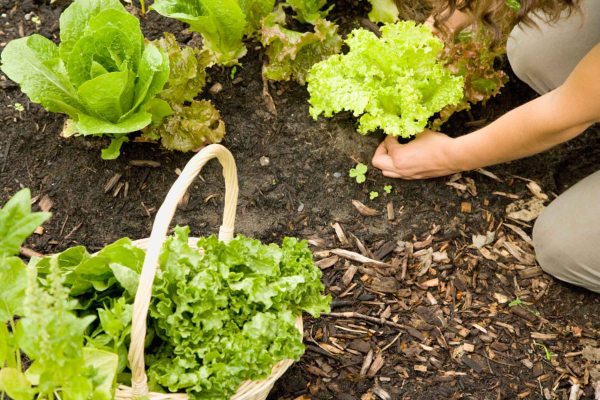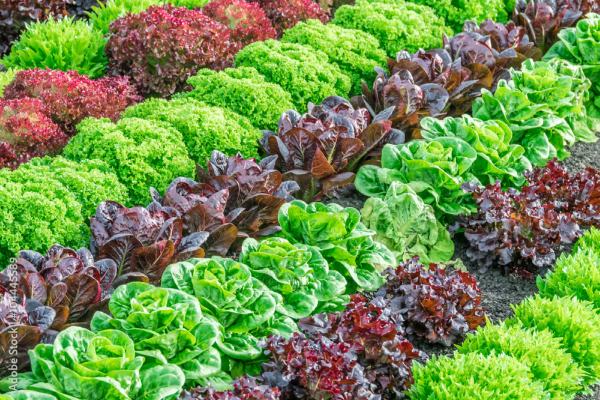Fresh lettuce from your yard can definitely add taste to your dishes while also increasing health benefits. There are several types of lettuce available, including iceberg, romaine, butterhead, and leaf lettuce, each having its distinct flavor and texture. Similarly, it is easy to cultivate and requires little effort, making it ideal for gardeners.
Here, we will learn more about lettuce including its types and how it is grown.
Introduction to Lettuce: A Versatile Leafy Green
Lettuce is such a popular leafy green vegetable that everybody loves because of its various uses and refreshing flavor. It is mainly used as an ingredient in a wide variety of foodstuffs, like making salads, sandwiches, wraps, and many others. Its gentle texture and mild flavor make the addition of crisp and freshness to any meal worthwhile. It enhances both taste and health in your favorite dishes such as classic Caesar salad or a belly-filling BLT sandwich. Additionally, this vegetable adds brilliant green color and delicate texture to a food presentation, whether you put a leaf of lettuce on a burger or some shredded lettuce on tacos.

Furthermore, growing lettuce at home is easy, which is why it’s a popular choice for home gardeners. All you need is good soil that drains well and enough sunlight. If you have these conditions, you can grow your one crispy lettuce all season long.
Types of Lettuce: Exploring Varieties and Flavors
There are many types of lettuce, all of which will give different tastes and textures to your salad. Let us discuss some of these variants.
Iceberg
Iceberg lettuce is the most commonly found lettuce you may come across in any grocery store. It is famous for its crunchy nature and mild flavor. It forms tight, compact heads with pale green leaves. The leaves are thick, and crunchy, but less in nutrients, except they supply dietary fiber. It takes about 70-80 days to mature and grows best in spring and fall. It is said that growing iceberg lettuce is challenging as it does not hold up well in hot weather conditions and excess or low amounts of water. Similarly, it could rot from the inside out if not properly taken care of.
Romaine
Romaine lettuce, also known as cos lettuce, has long, firm leaves with a slightly bitter flavor. They are often used in Caesar salads and add a nice crunch to sandwiches. This type of lettuce grows in upright heads also, with the leaves crisp and dark green on the outside and lighter on the inside. It takes 55 to 65 days to mature and can be grown in fall, spring, or summer. You can harvest the entire head when it is ready, or you can pick baby heads for softer leaves.

Butterhead
Butterhead is characterized by its soft, buttery essence and loose, tender leaves. It has a mild flavor and delicate texture that complements salads and sandwiches perfectly. Butterheads are easier to grow than other types and don’t easily go bad in hot weather. For the softest leaves, grow them in spring or fall. They’re usually ready to harvest in 55-75 days.
Loose Leaf
Loose leaf lettuces grow in clusters of separate leaves rather than forming a central head. These leaves can be frilly, smooth, or lobed, providing a range of appearances. They do like cooler temperatures so they would prefer spring and late summer planting. With loose leaves, harvesting is flexible. They are generally ready in about 50 days, but you can enter as early as 30 days. You can harvest the whole plant or just the leaves as it grows.
Batavian
Batavian lettuce, also called crisphead lettuce, has large, crunchy leaves that compose a loose head. This variety combines the features of both iceberg and leaf lettuce and has a crispy texture with a sweet flavor. You can use Batavian lettuce in salads and sandwiches and as a means of decoration for dishes. This is one of the greatest varieties of lettuce to grow in summer. It took the days to maturity is approximately 55-60 days, and it could be harvested throughout the whole season.
Growing Lettuce: Tips for Successful Cultivation
Examine the Right Variety
Choose lettuce varieties suitable both for the local climate and available space. You will need to select one of the four main types of lettuce including loose-leaf, romaine, butterhead, or iceberg, each has its own taste and texture. You must also look at how long it takes to get lettuce ready for harvesting and make sure it just fits within your gardening schedule. Also, consider if the lettuce can handle diseases or hot weather in case you are planning to plant it during summer.
Select Right Location
Lettuce plants grow healthy in sunlight. Therefore, select a sunny area with good soil to ensure optimal growth. Though lettuce takes full sun, it prefers a bit of shade, which is especially needed at noon. You should plant them beside taller vegetables like eggplant, peppers, or tomatoes so that these will partly shade the plants. On the other side, the lettuce seeds prefer lower temperatures in soil to germinate well.

Plant in the Right Time
Planting lettuce seeds or seedlings at the right time is very important. Lettuce does better in cooler weather, directly sow seeds in early spring or late summer. If temperatures are going to stay above 85°F in late summer, plant under shade or put shade cloth over your seeded area to temper the heat. While lettuce can withstand cold weather, if it is going to freeze hard, you may cover your plants with cloth or special covers to keep them safe and grow longer.
Watering
Make sure the soil stays damp but not too wet because lettuce likes moderate moisture. Check for dryness every few days, and water only when the soil is dry about an inch down. If you are growing your lettuce in a container, you may have to water it frequently since it can dry out very fast.
Mulching and Weeding
Using mulch helps to keep the soil moist and at the right temperature. Weeding, on the other hand, prevents weeds from crowding lettuce and restraining its ability to flourish. By mulching and weeding often, you make sure the lettuce has the best conditions to grow and stays healthy as it grows.
Fertilization
In most situations, lettuce does not need heavy fertilization, particularly when grown from seed or transplanted from seedlings. Unless your soil is very productive, there is no need to fertilize. If the plants appear a little weak, with faded leaves, then only lightly treat them, and this will provide essential nutrients for healthy growth. Just be careful not to use too much fertilizer because it can hurt the young plants. Make sure to use a balanced fertilizer
Proper Harvesting
To harvest lettuce properly, wait until the leaves are large enough to eat but still tender. Use clean scissors or a knife to cut the leaves above the bottom of the plant, leaving about an inch of stem to grow back. Similarly, start by picking the outer leaves so the inner ones can keep growing. Or you can cut the whole head off at the bottom.
Also read, How to Plant and Grow Bush Honeysuckle
Frequently Asked Questions
1. When is the best time to plant lettuce?
Lettuce thrives in cooler weather, so aim to sow seeds in early spring or late summer.
2. What types of lettuce are there?
Lettuce comes in various types including iceberg, romaine, butterhead, and leaf lettuce, each have its unique taste and texture.
3. How do I grow lettuce?
Growing lettuce at home is easy. All you need is good soil that drains well and enough sunlight. If you have these conditions, you can grow your one crispy lettuce all season long.
